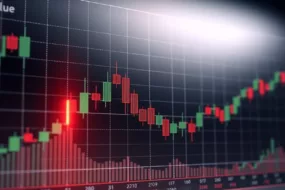
Top 9 Crypto Trading Patterns
Cryptocurrency’s meteoric rise has made it a magnet for investors. But those wild price swings can feel like a rollercoaster ride. Want to trade crypto with more confidence? Understanding chart patterns is your key to navigating the market like a pro.
This comprehensive guide dives deep into the most essential crypto chart patterns. We’ll break down their formations, what they signal about future price movements, and how to leverage them for profitable trades. No matter if you’re a seasoned investor or a crypto newbie, this guide will equip you with the knowledge and tools to make informed decisions and potentially supercharge your crypto trading journey.
Key Takeaways:
- What are crypto chart patterns and why are they important?
- 8 helpful strategies for starting cryptocurrency trading
- Common mistakes to avoid when using crypto chart patterns.
- Download the Mudrex all to start your trading journey with ease.
What Are Cryptocurrency Chart Patterns?
Cryptocurrency chart patterns visually represent historical price movements in the cryptocurrency market. These patterns emerge from collective trader interactions, offering insights into future market trends and directions.
Over time, these patterns have become invaluable across various financial markets, including stocks and forex. They serve as reliable tools for predicting and projecting price fluctuations, establishing their significance in trading strategies.
Why Use Chart Patterns in Cryptocurrency Trading?
Using chart patterns provides a structured approach to making trading decisions. They aid in anticipating price movements and strategizing entries and exits strategically. Many successful traders leverage chart patterns to achieve substantial financial gains. For example, the renowned head and shoulders pattern effectively predicts market reversals.
Key Cryptocurrency Chart Patterns for Every Trader
1. Head and Shoulders Pattern
The head and shoulders pattern features three peaks: a higher peak (the head) flanked by two lower peaks (the shoulders). Typically observed at the end of an uptrend, it indicates a potential market reversal. To validate this pattern, traders frequently wait for a breach below the neckline (support level). The distance between the head and the neckline is used to estimate the target price.
2. Double Top and Double Bottom Patterns
Understanding double tops and bottoms helps traders anticipate price reversals after prolonged uptrends or downtrends.
Double Top
A double top emerges after a significant uptrend, signaling a potential reversal. This pattern consists of two peaks at similar levels separated by a trough. It suggests waning upward momentum and an impending downward trend.
Double Bottom
A double bottom appears at the end of a downtrend, indicating a possible upward movement. It comprises two troughs at similar levels separated by a peak. This pattern indicates a diminishing downward trend and the potential for a bullish reversal.
3. Triangles: Ascending, Descending, and Symmetrical
Triangles are versatile patterns that can indicate continuation or reversal of trends, depending on their orientation.
Ascending Triangles
Ascending triangles feature a flat top line and an ascending bottom line. These patterns generally signify bullish trends, suggesting an impending breakout above the resistance level. Traders interpret ascending triangles as indicators of potential upward price movements, breaking through established resistance points.
Descending Triangles
Descending triangles are characterized by a downward-sloping top line and a flat bottom line. These patterns typically indicate a bearish outlook, suggesting an imminent breakout below the established support level. Traders viewing a descending triangle anticipate continued downward trends, potentially identifying selling opportunities in the market.
Symmetrical Triangles
Symmetrical triangles are common in trading, forming when two trend lines intersect, foreshadowing an imminent breakout. Traders closely monitor price movements within these triangles, anticipating significant upward or downward shifts. A breach above the upper trendline or below the lower trendline signals potential trading opportunities.
4. Cup and Handle Pattern
A teacup with a handle is what the cup and handle pattern looks like. The “handle” indicates a brief period of stability preceding a breakout, while the “cup” produces a rounded bottom. This pattern typically forecasts a bullish continuation, with prices expected to rise after completing the handle formation.
5. Flags and Pennants
Flags and pennants are short-term continuation patterns that signal a temporary pause in the market before the trend resumes.
Flags
Flags are small rectangular patterns that appear when the market pauses briefly after a sharp price movement. These formations suggest the continuation of the current trend direction. Flags serve as indicators of sustained market momentum, aiding traders in making informed decisions based on anticipated trend continuations.
Pennants
Pennants resemble symmetrical triangles, forming after significant and rapid price changes. These patterns indicate continued trends in the original direction. Pennants typically manifest following substantial price movements before resuming the trend.
6. Wedges: Rising and Falling
Rising and falling wedges are patterns that traders use to predict price reversals based on the slope and direction of the wedge.
Rising Wedges
Rising wedges slope upward and signal bearish reversals. To start short bets, traders watch for a breakdown below the wedge’s lower limit. This pattern is defined by higher highs and higher lows converging towards a single point, indicating weakening bullish momentum.
Falling Wedges
Falling wedges slope downward, suggesting bullish reversals. Traders await a breakout above the upper boundary of the wedge to initiate long positions. Falling wedges feature lower highs and lower lows converging, indicating diminishing bearish momentum.
7. Rectangles: Continuation and Reversal Patterns
Rectangles are price consolidation patterns that help traders predict whether the current trend will continue or reverse.
Continuation Rectangles
Rectangles form when prices consolidate within a horizontal range, signaling ongoing trend continuation. These patterns indicate a period of price consolidation preceding the resumption of the existing trend. Continuation rectangles typically emerge amidst robust trends, providing a resting phase before subsequent price movements.
Reversal Rectangles
Reversal rectangles suggest potential trend reversals. Unlike continuation rectangles, these patterns indicate market preparation for a directional shift. Reversal rectangles generally appear after, signifying changing market sentiments.
Rounding Bottom
A “U”-shaped rounding bottom frequently heralds long-term turns from bearish to bullish patterns. This pattern typically forms over extended periods, reflecting gradual shifts in market sentiment from bearish to bullish.
8. Triple Top and Triple Bottom Patterns
Traders employ triple tops and bottoms, which are uncommon but effective reversal patterns, to forecast significant trends.
Triple Top
Triple tops emerge after three peaks at similar levels, indicating strong resistance. This pattern points to important levels of market support as well as possible bullish reversals. Triple tops are more potent than double tops due to their additional resistance test.
Triple Bottom
Triple bottoms appear after three troughs at similar levels, indicating robust support. This pattern suggests significant market support levels and potential bullish reversals. Triple bottoms are stronger indicators of trend reversals compared to double bottoms.
9. Bullish and Bearish Engulfing Patterns
Engulfing patterns are strong reversal signals that occur when one candle completely engulfs the previous candle, signaling a potential change in market direction.
Bullish Engulfing
Bullish engulfing patterns occur when a small bearish candle precedes a larger bullish candle, signaling potential upward reversals. This pattern is compelling following downtrends, indicating bullish momentum.
Bearish Engulfing
Bearish engulfing patterns are the converse, indicating potential downward reversals. Identified by a small bullish candle followed by a larger bearish candle, this pattern suggests strengthening bearish sentiments.
Common Errors to Avoid
Mistakes include misidentifying patterns and acting prematurely on incomplete patterns. Always await confirmation before trading. Using multiple indicators verifies patterns. Inadequate risk management, such as failure to set stop-loss orders or incorrect position sizing, is another pitfall. Effective risk management is critical to sustained trading success.
The Significance of Risk Management in Cryptocurrency Trading
In any trading method utilizing chart patterns, risk management is essential. Even trustworthy patterns have the potential to falter, maybe with large losses. Key risk management strategies include:
1. Setting Stop-Loss Orders
Stop-loss orders establish predefined price levels at which trades automatically close to prevent further losses. Proper stop-loss placement based on chart patterns and market conditions mitigates downside risks and safeguards capital.
2. Position Sizing
Position sizing determines the capital allocation per trade. Never take on more risk than a small portion of your overall capital, usually 1% to 2% per deal. Adequate position sizing manages risk and prevents excessive losses from a few unsuccessful trades.
3. Diversification
Diversification involves spreading investments across different assets or markets to reduce risk exposure. By diversifying portfolios, traders mitigate the impact of underperforming assets on overall returns. In cryptocurrency trading, diversification may include trading various cryptocurrencies or combining crypto trades with other financial instruments.
4. Using Leverage Prudently
With less cash, traders can manage greater bets thanks to leverage. Leverage can improve profits, but it also raises the possibility of significant losses. Traders need to be cautious and mindful of sudden, substantial losses.
5. Emotional Discipline
Having emotional control is essential for profitable trading. Steer clear of quick decisions motivated by feelings such as greed or fear. Maintaining emotional control and sticking to a clear trading plan reduces costly errors and increases trading consistency.
6. Developing a Trading Plan
A trader’s strategy, including entry and exit points, risk management guidelines, and performance assessment, are outlined in a thorough trading plan. A well-crafted trading plan provides a structured framework for decision-making, fostering focus and discipline.
The Role of Automated Trading in Cryptocurrency Markets
Automated trading systems are increasingly popular in cryptocurrency markets for executing trades based on predefined criteria. These systems leverage chart patterns and technical signals efficiently, enhancing trading performance.
Advantages of Automated Trading
Everything has some advantages that will impact the future. Here are some advantages of Automated Trading:
Efficiency and Speed
Automated trading systems execute trades swiftly and efficiently, ensuring traders capitalize on potential opportunities without delay. They monitor multiple markets simultaneously and act promptly based on predefined rules.
Emotion-Free Trading
Automated systems eliminate emotional bias in decision-making, ensuring trades are executed based on logic and strategy rather than emotional impulses. This fosters consistent trading outcomes and adherence to trading plans.
Backtesting and Optimization
Automated trading platforms often include Backtesting features for testing strategies using historical data. This helps refine strategies and identify potential weaknesses before applying them in live markets.
Access to Advanced Strategies
Automated trading systems carry out intricate techniques that are difficult to carry out by hand. These include technical signals, chart patterns, and techniques that combine several indicators.
Considerations for Automated Trading
While automated trading offers many benefits, you should navigate it by keeping a few things in mind such as:
System Reliability
Choose automated trading platforms renowned for reliability and performance stability. Regular monitoring ensures systems function as intended.
Strategy Development
Careful planning and testing are necessary for the development of successful automated trading methods. Emphasize solid tactics that can be adjusted to different market circumstances. Keep your strategy effective with regular reviews and modifications.
Risk Management
Despite automation, risk management remains critical. Establish appropriate stop-loss levels and position sizes to safeguard capital. Diversifying across strategies and assets mitigates risk exposure.
Regulatory Compliance
Adhere to applicable regulations governing automated trading practices, including leverage and margin use. Understanding regulatory requirements ensures compliance and legal operation.
Conclusion
Chart patterns are indispensable tools for predicting market movements accurately in the field of trading and investing. They provide traders with valuable insights into potential price movements based on historical price data and market psychology. Traders can increase their trading success by identifying and comprehending these patterns, which will help them decide when to enter or quit positions.
One platform that supports this integration is Mudrex, the best-automated trading platform renowned for its effectiveness. By leveraging chart patterns and technical signals within Mudrex, traders can optimize their trading strategies to achieve greater efficiency and potentially higher returns. This combination allows traders to capitalize on market opportunities more effectively, ensuring they stay ahead in dynamic trading environments.
Download Mudrex and Start Your Crypto Trading Journey Now
FAQs
1. What is the most reliable cryptocurrency chart pattern?
Head and shoulders and double tops/bottoms are among the most reliable patterns. They boast high success rates in forecasting market reversals and are widely recognized among traders.
2. How can beginners learn to identify chart patterns?
Beginners can start by exploring educational resources such as books, online courses, and tutorials. Practicing on demo accounts and utilizing trading platforms with pattern recognition tools builds experience and confidence in identifying chart patterns.
3. Are there tools to aid in spotting chart patterns?
Yes, platforms like TradingView and Mudrex offer features facilitating chart pattern spotting and analysis. These platforms provide advanced charting capabilities and pattern recognition tools, aiding traders in identifying and interpreting chart patterns.
4. Can chart patterns guarantee profits in cryptocurrency trading?
No, chart patterns provide valuable insights but do not ensure profits. Market conditions fluctuate, and unforeseen events impact price movements. Chart patterns should complement a comprehensive trading strategy encompassing risk management and thorough analysis techniques.
5. What should I do if a pattern fails?
If a pattern fails, reassess your strategy and consider implementing stop-loss orders to limit losses. Learn from the experience and adjust your approach to enhance future trading performance. Understand that no trading strategy is foolproof, and losses are inherent to trading.





